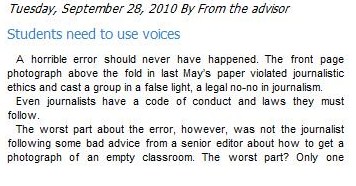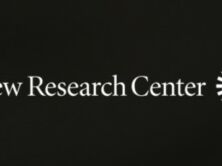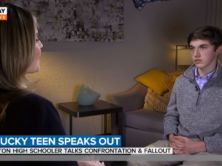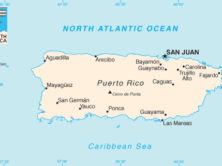
See above screenshot detail from the King's Page's advisor letter apologizing for publishing a misleading photo and requesting feedback from its readers. (Credit: King's Page High School, Milwaukee, Wisconsin)
The adviser for a Wisconsin high school newspaper penned an editorial letter to the newspaper’s readers last week following the newspaper’s publication of a misleading photo.
In the Sept. 28 edition of The King’s Page, the newspaper for Milwaukee, Wisconsin high school Rufus King International High School, adviser Kerry Thomas wrote that “a horrible error should never have occurred.”
“The front page photograph above the fold in last May’s paper violated journalistic ethics and cast a group in a false light, a legal no-no in journalism,” Thomas explained. She furthered used the incident as an opportunity to ask readers to give feedback and comments to the newspaper because only one person complained about the photo.
In September’s edition, the newspaper issued a correction both online and in the print version, along with Thomas’s letter.
The misleading photo accompanied a May 2010 front page story about skipping school.
As Thomas explained to StinkyJournalism via phone, the student journalist had – under the advice of a senior editor at the school newspaper – gone to an International Baccalaureate class during exams to take the photo. Since many of the students were not in class because they were taking other exams, the classroom pictured looked empty. But, even though there were reported to be approximately 20 students in the room at the time, the student journalist took the photo to show just a handful of students.
The September issue of The King’s Page is the first issue since the May edition. The King’s Page is published roughly 8 times a year, or every five weeks and is in its third year of publication after having become defunct in the 1990s, Thomas told iMediaEthics.
Thomas said she learned that the published photo was misrepresentative from the teacher whose classroom was photographed. The teacher, Jessica Huber, e-mailed Thomas about the photo, and as a result the student journalist had to formally apologize to the class before taking his year-end exams.
“As frustrating as it was to find out the last day of school that we published something that misrepresented an entire class…it ‘s been a learning experience,” Thomas said.
“My motivation for writing the article was certainly the ethics…but more because we’re trying to build a culture of newspapers” at the school. By writing the letter, Thomas wanted to inform students and readers that they can write to the newspaper staff with complaints, comments and questions.
Jessica Huber, the teacher who spotted the misrepresentative photo and alerted Thomas and the newspaper staff, wrote in an e-mail to iMediaEthics detailing how the photo was obtained.
“I was asked by the student reporter if he could take a picture of the classroom, that he needed a ‘smaller’ group of students for his article. He was a student of mine in another class hour. The image misrepresented our class because we normally had 35 students in the IB Psychology course. The day the photo was taken about half of the class was taking another exam in IB History. The side of the room with the fewest number of students present was the side that was shown in the photo. I was giving the students their final project for the course, as they had already taken their IB exam in my course. The image ran with the headline about skipping, which none of my students who were absent were doing.”
Further, she added that she and her students were upset about their class being misrepresented as skipping.
“I contacted the newspaper about the error because my students in that class hour were highly upset that our class had been missrepresented in that manner. Our newspaper is obviously out on the Internet, distributed to the school board, and the surrounding neighborhood as well as our school community. I was unhappy that the idea being presented was that my students were so disengaged with what was happening in my classroom that they would skip. It reflected poorly on them, me and the IB program at our school,” Huber explained.
Ethics
For her own part, Thomas explains she didn’t come from a journalism background prior to becoming the newspaper’s advisor. But, she did take Reynolds High School Journalism Institute, what she called “a two-week boot camp for journalism teachers.” There, she says the dean told teachers they can easily teach writing, editing and interviewing. But, what is key is ethics.
So, Thomas says in her newspaper course “I start with ethics, before story plans, interviewing, reporting.” She forms her instruction through resources from the Reynolds Institute and Student Press Law Center (SPLC), and “the SPJ code of ethics is our code of ethics.”
Because newspaper staff members must be sophomores through seniors, students currently on staff are familiar with last spring’s misrepresentative photo.
Newspaper at the school is “a limited public forum,” so the school administration has no hand in determining or screening content, Thomas explained. Further, “students actually drive the content” — choosing stories, making assignments and determining placement.
Thomas’s ethics teaching focuses on the six big areas the SPLC suggests. Specifically, she mentioned “I’ve been really clear with ‘you can’t take stuff from the web.'” The six issues discussed in the SPLC media law presentation on press freedom are:
- Censorship
- Libel
- Invasion of privacy
- Copyright
- Access to information
- Reporter’s privilege






